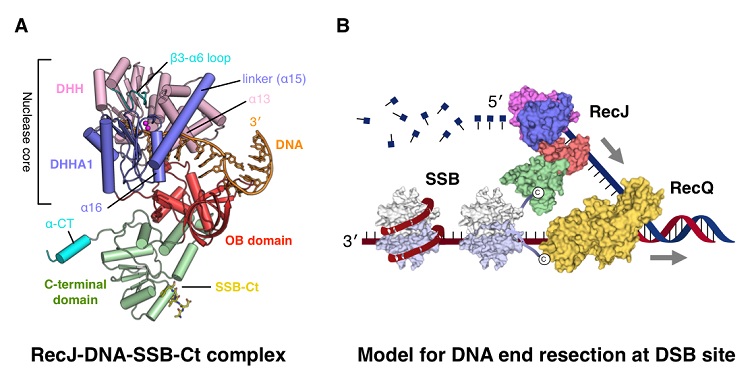The research team led by Prof. Hua Yuejin at the College of Agriculture & Biotechnology of Zhejiang University published an article entitled “Structural basis for DNA 5′-end resection by RecJ” in eLife on April 8.
DNA double strand breaks (DSBs) are the most lethal forms of DNA damages. In contrast to other types of damage, in which at least one complementary strand is still available to template DNA repair, DSBs are more difficult to repair because of the free DNA ends. Defects in DSB repair are thought to be linked to cancer susceptibility and various human pathologies such as breast cancer and Ataxia telangiectasia. DNA end resection, which degrades the 5´ strands of DSB ends, is one of the earliest and most important steps in DSB repair.
RecJ, a representative member of DHH family proteins, is the only 5´ nuclease involved in RecF recombination repair pathway. Recently, the research team confirmed the role of this nuclease in DSB repair in Deinococcus radiodurans, the magic organism with extraordinary DNA repair capabilities (J Bacteriol, 2015; Front Microbiol, 2015). In the current study, the research team reports the crystal structures of RecJ protein in complex with dTMP, ssDNA and the C-terminal region of single-stranded DNA-binding protein (SSB-Ct). A terminal 5´-phosphate-binding pocket determines the 5´-3´ polarity of the deoxy-exonuclease of RecJ; a helical gateway at the entrance to the active site admits ssDNA only; and the continuous stacking interactions between protein and nine nucleotides ensures the processive end resection. The active site of RecJ contains two divalent cations that coordinate the nucleophilic water. The C-terminal domain of RecJ binds the SSB-Ct, which explains how RecJ and SSB work together to efficiently process broken DNA ends for homologous recombination.
This study was supported by National Basic Research Program of China, National Natural Science Foundation of China and Zhejiang Provincial Natural Science Foundation for Outstanding Young Scientists.
Publication link: http://elifesciences.org/content/5/e14294v1
